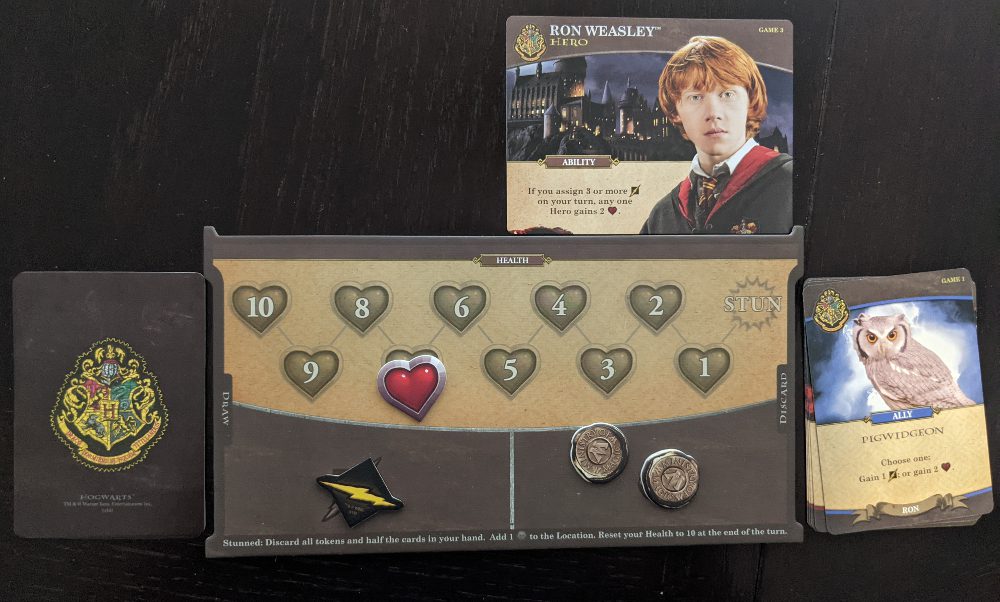Disclosure: Meeple Mountain received a free copy of this product in exchange for an honest, unbiased review. This review is not intended to be an endorsement.
I am a big fan of deckbuilders, but co-op and Harry Potter? Not so much. The relationship I have with the Harry Potter intellectual property is as neutral as Switzerland. I don’t love or hate the franchise; I acknowledge its existence and move on. My attraction for this game sprouted from my curiosity as a deckbuilder with a cooperative legacy campaign.
Before we continue any further, this is a full spoiler review. This game is about half a decade old, and there are plenty of other spoiler-free reviews. It’s in my nature to go into obnoxious detail about the games I review, and this one is no different.
Departing From Platform 9¾
Welcome to Hogwarts. You’re a Wizard, and there are some Villains. Your task is to prevent the Villains from taking over every location card. To do this you need to defeat all the Villains by zapping them with your deck. The deckbuilder portion works the same as with most any other card game in the genre: you draw a hand of 5, play one card at a time to do its effect, and then buy cards from the market to put in your discard pile. After you complete your turn, the cards go in the discard pile, and you draw five cards from your deck.
Each turn is a simple process. The first step is to draw a card from the Dark Arts deck and deal with its effect, following the familiar “nasty stuff happens” phase in all cooperative games. It can be anything from smacking at your health to slowly taking over the current location card. After resolving the Dark Arts card, the Villains will raise their hands like eager schoolchildren and remind you of their painful abilities that further hurt your teammates.
Once the pain resolves, you can play your cards as I have mentioned before. You will most likely encounter cards that enable you to attack a villain, gain some health, or spend currency to buy cards. If your health hits 0, you discard half your hand, and the current Location card is at risk. Currency can buy cards from the face-up marketplace, ensuring your future turns will have a bigger impact. An important note about currency is it doesn’t carry from turn to turn, so you need to spend it or lose it. Some card effects give tokens to other players, giving them a boost to buy cards or attack a Villain.

Easier Than Casting Wingardium Leviosa
To some of you, what I am describing is the basic deckbuilding framework, and that is by design. The Op is the publisher here, who is well-known for creating licensed games that families can enjoy. Good evidence of this is the rulebook and the game structure itself. Unlike many other rulebooks, newcomers of the hobby can find this one understandable. The first two games out of this seven-game campaign massage the players into the deckbuilder genre. The rulebook even suggests for experienced players to skip to Game 3.
As for the theme itself, although I have admitted that I’m not into Harry Potter, my co-op partners are big fans of the franchise. Watching them ruffle through the decks and glee at the various Ally and Item cards was practically a separate game for them. I guess I can say with confidence that fans of Harry Potter will feel at home here.
So far, everything sounds good, but where’s the co-op in all of this? Before you start the game, you pick your character, such as Harry Potter or Hermione Granger, with each character having a custom deck and special ability. If you are playing with less than four players, there will be some chit-chat involved here. It is also crucial to watch out for the Villains since there are currently two Villains on the table, but the number will eventually reach three in future games. Your team must decide which Villains are a top priority by evaluating their health and abilities. Even the marketplace is a roadblock in this optimization puzzle, since you will need to discuss which cards people should buy.
Just As Much Teamwork As Quidditch
I love how Harry Potter: Hogwarts Battle involves discussion with everyone at the table while being open about the situation. I’m used to cooperative games using hidden elements under the rug and requiring an assured “meta” thinking to play well. Hogwarts Battle gives your group all the information they need to make informed decisions, thus providing a more welcoming experience for newer people to the hobby.
As you progress through the campaign, the puzzle becomes more difficult to figure out. More and more mechanisms appear as stronger Villains stomp their way into the Villain deck. After Game 3, House Dice are your first new mechanism. Yes, dice.
There will be cards in the market deck that will allow you to roll one of the four dice when used. Simply put, roll the die, and everyone gets the benefit such as drawing cards, health, or currency. It is so dumb, yet I love it. I can’t fathom the reason, and honestly, I don’t want to. It is a random bonus that everyone benefits from, and my group gets excited when the rolling starts. A strange part of me wishes more deckbuilders would throw dice into their games.

He-Who-Must-Not-Be-Named
The next mechanism is the big baddie himself, Voldemort. He is the final Villain, and he is face up at the bottom of the Villain deck. His effect is painful and has plenty of health to sustain your onslaught. Another deal with him is he is technically face up, so when he is present, you are dealing with the effects of four Villains instead of the usual three. Also, the other Villains need to be defeated before you can touch him. Good luck.
After Voldemort, you have the Proficiency cards. Without a doubt, this is my favorite feature in this game. These cards grant you special abilities in combination with your character ability, and you’ll pick one at the start of the game. This gives your group plenty of control and experimentation.
The last addition to the game comes in the last Game 7. Horcrux cards come into play, making me glad I am reviewing the game instead of doing a video. I might have a hard time pronouncing that one. These six cards are played in a specific order and function like a Villain card with their own effects. Unlike Villains, you can only remove them by rolling specific die symbols, urging you to buy those dice rolling cards as soon as possible. You can’t ignore the Horcrux cards either, because you need to get rid of them before you can even touch Voldemort.
Disappointing Grades
I have to confess that watching this game come from the simple Game 3 rules to Game 7 was an intriguing trip. It turned a rather mundane deckbuilder into one that is meaty for an entry-level deckbuilding game. Harry Potter: Hogwarts Battle has many variables and topics to discuss, leading to both a mechanical and emotional experience with your friends. It was also at Game 7 that my group decided to give up.
Challenging cooperative games such as the likes of Bloc by Bloc, Spirit Island, or Ghost Stories aren’t new to me. It is difficult to design a game where it beats you down like you owe it money and you ask for more. You can compare it to a demanding video game that is hard to beat, yet mastering it is part of the fun.
Hogwarts Battle’s structure is like a cheap mansion. Sure, it looks good, and the floor plan is excellent. It’s spacious, and the view from your bedroom looks like a living painting. However, knock on the walls, and the sounds of cheap material bounce between your ears. You check the basement, and you notice the cut corners to keep this entire thing standing.

No Arc In This Story
The primary culprit is the Villain deck. As the game progresses, the Villains arm themselves with higher health numbers and potent effects. Some of them are just straight upgrades of the older Villains. However, nothing is stopping the stronger villains from being the first ones you face. Deckbuilders are all about needing time to build your deck, and the game’s random system goes against that notion. In this game, the difficulty is not like a curve, but more of a heartbeat monitor. It spikes and then drops to nothing at an unpredictable rate.
Even the market deck gets punished for this as well. You could end up where the market cards are too expensive for your starter decks to buy. It is also quite possible where there aren’t enough healing items to help counter the back-to-back onslaught of Dark Arts and Villain cards that constantly diminish your health.
Player scaling is also another victim in all of this. If you play with the full player count, the game becomes noticeably more difficult due to the game’s structure. For each chance that you get to upgrade your deck, you must go through four Dark Art card draws that slap your team. Everyone is building their deck far more slowly than what the Villains can dish out.
Like a good joke or a story, it’s all about the execution. I love some elements in this game. The dice? Interesting stuff. Proficiency card? Love it. The Horcrux cards? Chef’s kiss. These enjoyable features get downplayed by a system that makes difficulty as consistent as a toddler in a candy store. It is a game full of wasted potential.
For an alternate take, find out what Kathleen Hartin thought of Harry Potter: Hogwarts Battle.












Add Comment